|
REVIEW ROUNDUP: DIMWIT-STUMPERS
Stu's Super-Awesome DS Review Bonanza Part 3: Puzzle Games
If there are two things the Japanese really love, that aren't schoolgirls' underwear or giant lizard monsters or game shows where people are sadistically tortured for laughs, then they're the Nintendo DS Lite and puzzle games. With its touch-screen interface, handwriting recognition and handy pocketability, the little handheld is ideally suited to all sorts of puzzlers, from classic Tetris-style falling-block games to pen-and-paper puzzles like Sudoku, but whereas in the West those two titles represent pretty much the beginning and end of our concept of puzzling, the Japanese market is a fount of invention in both action-puzzle and logic-puzzle genres. It's a real shame that most of these games have no prospect of a Western release (and weirdly, despite having a minimum of text, are far less kindly treated in terms of English accessibility than most Japan-developed titles), so here's a collection of stuff that's almost certainly escaped your attention before now. (If you haven't managed to pick up on Zoo Keeper, Polarium, Tetris and Meteos for yourself, there's no hope for you.)
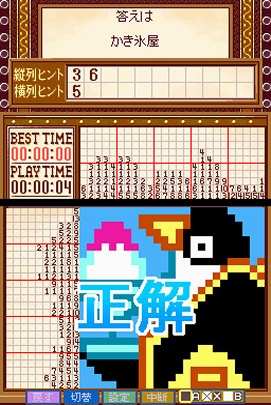 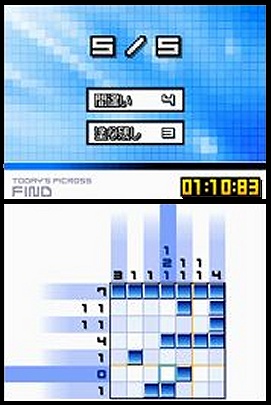
Illust Logic's puzzles are played in monochrome, then displayed in colour when you beat one.
PUZZLE SERIES VOL.6: ILLUST LOGIC (Hudson Soft)
Picross games are huge in Japan. Going under a wide range of alternative generic names (of which Illust Logic is one, along with Nonograms, Oekaki, Griddlers, Pixel Puzzles and many more), they've been a staple of most Japanese consoles since the days of the SNES and the original Game Boy. (The only one ever released in the West was Mario's Picross on the GB, a particularly good version which nevertheless flopped disastrously.) They're absolutely brilliant puzzles, in which you have to construct a picture by logically deducing from numbers on the side of a grid which of the pixels in the picture should be filled in and which are blank. (It's not a million miles removed in basic structure from Mine Sweeper, in fact.)
This particular release comprises 300 puzzles, with grids ranging from 10x10 to terrifying 25x25 sizes, and in common with the other Puzzle Series titles you earn stars for completing each puzzle depending on how long you took, which are used to unlock later puzzles. The screen layout is well designed to allow the maximum possible block size if you want to use the stylus to play, but the d-pad/button controls are fast and slick and generally superior. There's a lot of Japanese menu and option text to wade through, so some of the more advanced features will remain a mystery, but it's easy to get to the basics. If you've never played Picross before, this is an excellent place to start. 8/10
------------------------------------------------------------------------------------------
PICROSS DS (Nintendo)
Unusually, given the company's long history of excellent Picross titles, Nintendo's own take on Picross on the DS initially seems a ham-fisted effort. Absolutely swamped in Japanese menus (with the occasional inexplicable English "Level 1" or somesuch), it's a chore to find your way to any actual puzzles, and when you do you're forced to use a pointlessly complicated touchscreen-and-d-pad control system that makes the process of playing awkward and obstructive - it's almost impossible to concentrate on the puzzles because you're too busy thinking about the controls. Much worse than the basic control system, though, is the display layout. For puzzles larger than 10x10, you're forced to use a scrolling screen, also controlled unintuitively with the stylus, which is so mindbogglingly horrible and contrary to the entire principle of Picross (which is about cross-referencing information from the entire grid to make the logical deductions) that it effectively renders the larger grids unplayable. However, take a few random stabs at the menu options and you'll find that you can both get a locked full-screen view of the scrolling grids, and play with the d-pad and buttons, which for the larger puzzles is much easier.
It's a little limited in scope compared to Illust Logic, with nothing bigger than 15x15, but it compensates with Daily Picross, a mode in which you get five little quickfire 7x7 grids to solve against the clock. After a few days it gradually unlocks new Daily modes too, including one where you're not allowed to use Xs, and another where you're presented with an already-filled puzzle in which you have to spot and correct the errors. For Wi-Fi players there's also the opportunity to download lots of extra puzzles, including those from the original Mario's Picross on GB, and Daily Picross and the other extra content just about manages to rescue an initially lacklustre package. This one's coming to the UK, and it'll definitely be well worth a buy when it's all in English. In Japanese it's a bit of a pain. 7/10
------------------------------------------------------------------------------------------
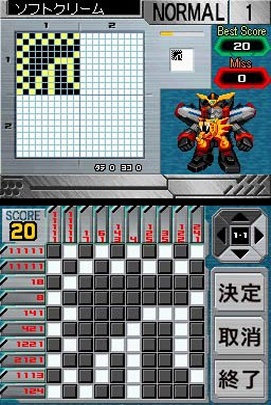 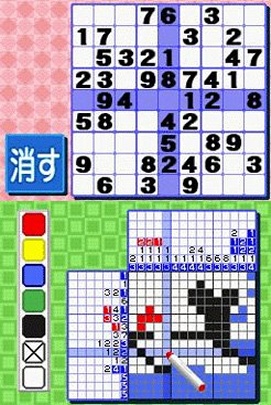
That's a composite screenshot on the right, by the way.
OEKAKI PUZZLE BATTLE (Sunrise)
Our third Picross-related game is the weirdest. Partially borrowing a feature from Mario's Picross, it doesn't have a clock recording your time for a puzzle, but rather a "score" which is actually a number of lives. You can't mark an "X" in squares that definitely aren't filled, but rather you have to go across the grid flagging squares you think ARE filled (as many or few at a time as you like), and then hit the top button at the right-hand side of the screen to enter your selection. If all are correct, they'll switch from flagged orange to solid black. If any are wrong, none will fill in and you lose a point. This simple change makes the game rather more difficult, although it does help you by lighting up a row or column in red once you've completed its squares, to help you discount it for other lines.
The other significant difference about Oekaki Puzzle Battle is that the four groups of levels (30 each) increase exponentially in size. Easy levels are 10x10, Normal levels are four 10x10 grids in a 2x2 square forming a single picture (you treat each grid separately rather than scrolling around), Hard stages have nine 10x10 grids (3x3) and the Super Hard levels are - you guessed it - a terrifying sixteen 10x10 grids making one giant 4x4 picture. (You do at least get more lives as you ascend the four difficulty levels - 10, 20, 50 and 99 respectively.) There doesn't seem to be any kind of mid-stage save facility - and there aren't many menus for it to be hiding on, so it almost certainly isn't there, rather than me just not being able to find it among all the Japanese option text - so if you've done 12 grids of a Super Hard level but are stuck on the last four and your red battery light comes on, you're in a lot of trouble.
To be honest, there isn't a lot of compensation for this brutally uncompromising approach. When you beat a level (each of which is nominally a battle against a traditional Japanese SD mecha robot thing, you get a little cutscene, but that's about it for motivation, except the chance to beat your own high score on each level, which DOES get saved. (It's also very weird when you complete a gruelling 2x2 level to defeat a mechanical fighting machine with what turns out to be a picture of an ice-cream cone). If you want an ultra-hardcore Picross challenge then this is definitely the place to be, but it'll be a little much for most people. 6/10 ------------------------------------------------------------------------------------------
ESSENTIAL SUDOKU (D3 Publisher)
It's Sudoku! It's Picross! It's Sudoku and Picross! It's, er, Essential Sudoku. This is a weird and schizophrenic little release, which is just about the cheapest DS game you can buy in Her Majesty's Great Britain. (The RRP is £15, but you can pick it up from most online retailers for under a tenner). Despite the title, the cart's content is focussed equally on Sudoku and Picross puzzles (there are 1,000 of each), and the Picross element (or "Picture Puzzle" as it's called here) actually gets given precedence in the game itself. The Sudoku (or "Number Puzzle") half is hampered by some truly terrible handwriting recognition code which is utterly incapable of correctly identifying a "5" more than one time in 50 no matter how you draw it, but luckily you can enter numbers with the d-pad and "A" button instead and enjoy some perfectly adequate Sudoku antics.
The Picross puzzles are far more interesting, though. Uniquely among the DS' Picross titles, these are the more complex multi-colour type of nonograms, with slightly different rules (squares of different colours can be adjacent without a blank space in between, but consecutive blocks of the same colour still have to be separated). The need to select colours makes the interface rather more fiddly than in Illust Logic (the stylus isn't quite precise enough, and the d-pad/button controls could have been better thought out), and the front end is crudely minimalist but such minor quibbles are a small price to pay for such a huge collection of excellent Picrosses. In both games the puzzles are arranged into groups of 100, so you'll have to be stuck on 10 different puzzles before you're stymied, and there's a vast amount of head-scratching fun here for your money. In terms of hours of entertainment per pound, this is probably the best-value DS game ever released in the UK. 9/10
------------------------------------------------------------------------------------------
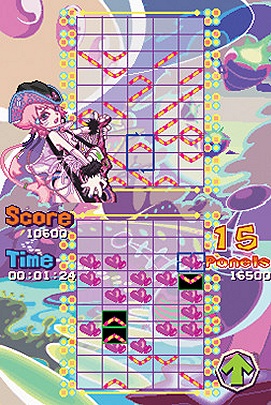 
Since most of these games are in Japanese, you'll see that we're explaining all the rules as we go.
GUNPEY (Bandai)
Named after Gunpei Yokoi, the late inventor of the Game Boy, Virtual Boy and Bandai Wonder Swan, this action puzzler is something of a sacred cow among gamers. Despite being almost a decade old it's been released very sparingly (prior to the recent DS and PSP titles, the only Gunpeys were the original Wonder Swan game and the Playstation 1 version, both back in 1999 and both only available in Japan), and invariably attracts the sort of breathless acclaim you'd expect from a rare, obscure cute puzzle game that's dedicated to a much-loved dead guy. Which makes it slightly disappointing that it's actually rubbish.
How it works is that diagonal and V-shaped tiles appear randomly from the bottom of the screen every few seconds (each new line of tiles pushes the whole grid up by one). The object is to move the tiles, by swapping vertically-adjacent ones, up and down the grid so that they form continuous lines from one side to the other. When that happens, the linked tiles disappear, and you keep playing until a tile is pushed beyond the top line of the grid.
So far so good, but there are major flaws in the basic gameplay design that suck out almost all of the challenge and fun. Firstly, if the game doesn't give you any tiles in a particular column, there's nothing you can do until it does, which is really boring. And secondly, the limited number of connection points on any given tile (just two on each side) means that the vast majority of the time, panicked random "scribbling" on the screen will make lines more successfully than careful planning (especially if you wait until the screen is almost full of tiles, then scribble like mad). The other versions of the game are just as dull, but the addition of the touchscreen control on the DS incarnation makes this one absurdly easy too, and you'll be doing well if you finish a game by having a tile pushed off the screen rather than by switching off the DS in boredom as you move into your fifth hour of play without ever being in any real danger. It's all very pretty and there are lots of modes and things to unlock, but it's a funless chore doing it and you'd be much better off just not bothering. 3/10
------------------------------------------------------------------------------------------
TOUCH PANIC (Nintendo)
So far over at the opposite end of the spectrum that it's barely part of the same reality, we find Touch Panic. A derivative of tile-shuffling games like Loco-Motion and Confuzion, it's a mind-numbingly complicated and difficult piece of mental torture that'll have most people running away from their DS and screaming. The idea is to manipulate the tracks so that your marble will intercept and collect other marbles (in specific colour sequences that you can bring up by pressing the Start button), dragging them along behind it in a snake formation before depositing them down a score-hole. But there are so many things to watch at once (including enemy marbles which are instant death to the touch, if you select the hardest difficulty), so much to remember, so much onscreen change with every stroke of the stylus, and so many menus and options to negotiate to get to a game at all, that most non-Japanese speakers will be reduced to helpless overwhelmed tears and give up within 30 seconds. (Which is exactly what I did the first time I ever tried to play it.)
The thing is, though, it's all so cutely and lovably done that it's still a lot of fun just to play the Time Attack modes (three, five or ten minutes), zoom around opportunistically collecting marbles and figuring out whatever you can on the hoof, and try to beat your high scores. It would have been even more fun if each of the Time Attack games had its own high-score table, but all you get is an overall top 5 specifying which mode and which difficulty level each score was achieved in, which is so deeply poor that I'm docking two marks for it. 5/10
------------------------------------------------------------------------------------------
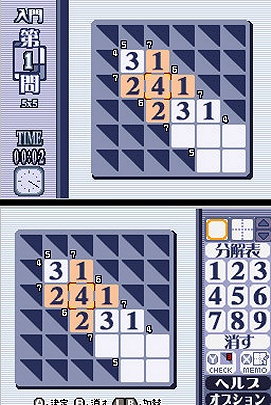 
You can move all the jigsaw pieces around at will to give yourself some clear work space.
PUZZLE SERIES VOL.4: KAKURO (Hudson Soft)
Part of an wide-ranging set of traditional parlour-puzzle games by Hudson, encompassing everything from crosswords to jigsaws, Kakuro is one of the most immediately accessible, both in terms of gameplay and front end. It's basically a hybrid of Sudoku and a crossword, in which you have to fill a grid with numbers from 1 to 9 so that (a) each horizontal and vertical line totals the number noted at the top/left of the line, and (b) no line has the same number in it twice. It's incredibly easy to get to grips with, and while the menus are all in Japanese it's always very obvious where you have to go. Starting off with simple 5x5 grids of two- and three-component numbers, the layouts (of which there are 300 or so) get more and more complex as you go on (reaching 13x21 with numbers comprising up to seven components), but are designed that even when you have to scroll the screen around you can always see everything you need to. You also get a mini-version of the entire grid on the top screen to help, along with a useful at-a-glance guide to certain number combinations (eg 23 in three squares is 6-8-9), and the stylus-and-d-pad interface couldn't be any easier to use.
Kakuro is a real eye-opener in play, as subconscious arithmetic logic directs you to instinctively fill in boxes far quicker than you could ever explain to an observer why you were doing it. If you think you're no good with numbers but want to feel like a maths genius, you might just find that this is the game you've been waiting for all your life. 7/10
------------------------------------------------------------------------------------------
PUZZLE SERIES VOL.1: JIGSAW (Hudson Soft)
And sure enough, here's that jigsaw game. It's impossible to imagine this being released for any other format - even on the DS it sounds a bit of a dubious idea - but it works surprisingly well. You get a couple of hundred puzzles, divided into four types across three difficulty levels (which basically govern the number of pieces, with 64 being the highest number I've found so far). There are your standard static jigsaws, entertaining animated ones where the picture's constantly moving as you're trying to solve it,, custom ones you draw yourself, and puzzles which aren't traditional jigsaws at all - you might have to place countries on a map (some of them needing to be rotated), or organs in a body, or four flags made up of colour bars and crosses (you're not shown which flags you're supposed to be constructing, or in which positions on the screen). I suspect that these puzzles have handy clues in the Japanese onscreen text, but so far I've managed to do them all using my own powers of deductive reasoning and a small amount of desperately dragging things around until they click into place. (With the normal puzzles, the game sticks pieces together for you when you connect them, and you can then drag all the connected pieces around as one. It'll also fix pieces in place when you drop them onto exactly the right spot.)
There are various helpful tools (eg you can clear away everything but side pieces, then bring the rest back when you've got the borders in place), and generally it's about as user-friendly as you could hope for. The pictures have varied themes, from cute kittens and Himalayan landscapes to various retro Hudson soft games (there are several Bomberman-themed puzzles, for example), and they all do something if you click on them after you've finished (the one of a puppy and a kitten barks and miaows), which is cute. I can't see that any of the puzzles will prove stupefyingly difficult - given the assists and the fairly small number of pieces you'll get them all eventually - but it's a likeable time-passer while it lasts. 6/10
------------------------------------------------------------------------------------------
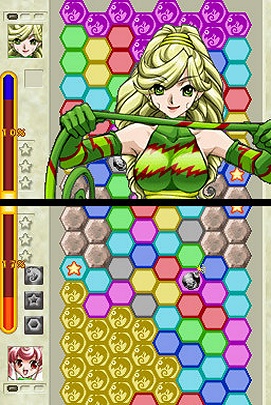 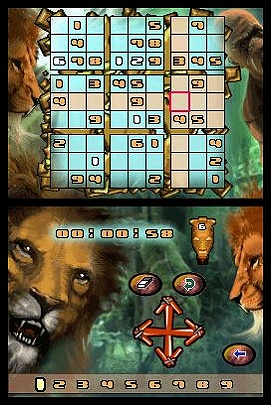
The developers of Sudoku Mania evidently spent all their time on the pretty backgrounds.
KURUKURU CHAMELEON (Starfish)
This slightly Go-related territory-capturing game is due to get a Western release under the name of Kameleon, and I recommend you either wait for that or play the game on the PSP instead, where there's English text. It's just too hard to figure out what's going on in this one, and although with lots of trial-and-error and perseverance you can just about play a game, you'll always feel (probably rightly) that you're missing most of what's happening. Even if you use the PSP version to teach yourself, there are too many options and cutscenes on the DS version to ever get a confident grip on it if you don't speak the lingo. 3/10
------------------------------------------------------------------------------------------
SUDOKU MANIA (Zoo)
It must have taken a lot of effort to figure out how to completely ruin something as simple as Sudoku on the DS, but hats off to the Zoo Digital team, because boy have they ever managed it. The second Sudoku game released in the UK (the first being Sudoku Grid Master, which is actually a translation of the only Hudson Soft Puzzle Series game so far to be brought to the West), Sudoku Mania is a hideous shambles which somehow manages to come up with a control system whereby the grid isn't displayed on the touch screen at all, and you have to select squares by - get this - touching cursor buttons on the touchscreen with the stylus (or using the d-pad), then select numbers either with the stylus or by cycling through them with the shoulder buttons. It's a method that could only have been contrived by a dribbling retard on some bad drugs, and the ambience isn't improved any by grotesquely scratchy music that'll set your teeth on edge. Throw in loading pauses (Loading! In a Sudoku game!) and infinite, randomly-generated puzzles that rob the player of any sense of progress or achievement, and what you're left with is a screw-up of spectacular proportions. 1/10
------------------------------------------------------------------------------------------
 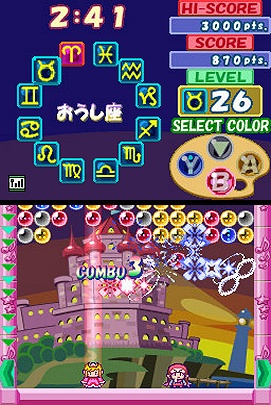
I have no idea what the significance of the zodiac symbols in Puzzle Kumikyoku is.
HONEYCOMB BEAT (Hudson Soft)
The vast majority of DS action-puzzle games can be further divided into two basic subcategories - tile-swappers like Zoo Keeper and Pokemon Link, and Tetris-derived falling-block games. Honeycomb Beat is one of the former, though really it's a variant on the old standalone handheld game Lights Out. You're presented with a grid of hexagons, and tapping one will cause both it and the six cells surrounding it to swap colour. In the main puzzle mode you get a fixed screen and a set number of moves (usually fewer than 10, which makes many of the puzzles look totally impossible at first glance, so it's hugely rewarding when you do solve one) to turn every cell on it the same colour. (Just to screw up our nice tidy taxonomy, there's also an arcade mode related to Tetris, where the screen scrolls upwards and your objective is to complete horizontal lines to make them disappear.)
The ultra-simple mechanic of the puzzle mode is complicated a little later on with the addition of special arrow icons which change whole rows of the board at once, and despite being so easy to instantly grasp, the game swiftly gets hair-tearingly hard, at least until you master the geometry of the swapping rules. The puzzle levels are interestingly structured in another honeycomb, ensuring that you've always got lots of different levels (of the 200 available) to be stuck on at any one time, and there are bonus backdrops and soundtracks to gradually unlock for a little variety. The game's in Japanese, but all the menus are subtitled in English so it's easy to navigate, and generally this is quality pick-up-for-five-minutes puzzling that'll keep you pleasingly bemused for many hours. 7/10
------------------------------------------------------------------------------------------
PUZZLE KUMIKYOKU (Hudson Soft)
Puzzle Kumikyoku, on the other hand, belongs to the falling-block line. Although in fact, nothing ever actually falls, which only goes to show what a tricky job categorisation is. Kumikyoku's closest relative is probably an old Data East coin-op called Magical Drop, though there are some obvious Puzzle Bobble parallels too. A wall of bubbles slowly descends from the top of the screen. You clear away the bubbles by firing your own bubbles up to make matching sets of them - blue bubbles pop when you make a vertical line of at least three, red ones go when they're in a horizontal line of at least three, and yellow ones need to be formed into squares of 2x2 or more. The challenge comes in quickly co-ordinating the three buttons that fire each colour of bubble as the wall advances towards you, and also in planning the order of removal in order to maximise your chances of making combos (by clearing another set while the previous one is still popping).
Sadly, as with Pokemon Link, that challenge arrives far too late. Unless I've accidentally chosen "drunken baby" difficulty from the dense maze of Japanese options, you'll have cleared hundreds of sets of bubbles before the wall gets anywhere near the floor, and while it's quite exciting when it finally does get a bit tricky, there isn't enough of a reward to make the long wait worthwhile. (Incidentally, apparently there are two retro games from the series also included on the cart, but I either haven't unlocked them or just can't find them.) 5/10
------------------------------------------------------------------------------------------
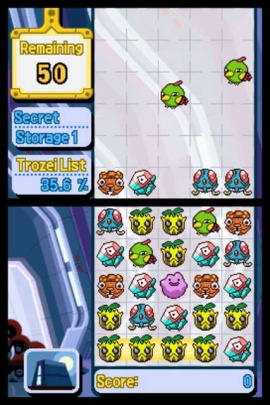 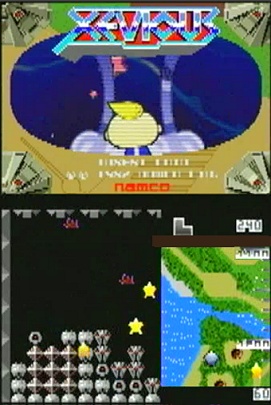
Alert viewers will note that Honeycomb Beat and Trion Cube originally appeared in Roundup #2.
POKEMON LINK (Nintendo)
If you wanted, for some reason, to sum up Pokemon Link in a single sentence, "Zoo Keeper for kids" would do the job pretty well. As various Pokemon fall from the sky, your job is to shunt rows and columns of them around so that you form horizontal or vertical lines of four or more little monsters. Do so and they disappear, giving you a brief chance to shift some more lines around and make point-scoring combos. The reason it's for kids is that being able to shift both rows and columns makes it very easy to tag lines together (since you can effectively move any Pokemon to any position in the grid), and you'll be a long way into the game before it starts to present you with any challenge. It's diverting enough for a while, but there's very little to it, and the boss battles in particular seem to go on forever. 5/10
------------------------------------------------------------------------------------------
TRION CUBE (Namco)
Curiously, most of the games in the second category of action puzzlers have been much less successful than the tile-swappers, and Trion Cube is a good example. It's a Tetris derivative, where you have to link Tetris-style blocks together to form solid structures, but the twist in this one is that you have to make "combos" - every time you add a block to the pile on the board, it has to complete a horizontal or vertical line of at least three squares attached to the existing stack (a stack starts when you create a 3x3 block), or your combo will die and all the blocks in it disappear. It's not a massively compelling concept, since your strategy is dependent on which piece the game happens to throw out next, and unlike Tetris where you can recover from a single unfortunate block and quickly get yourself back on track, one wrong shape here will undo all your good work and dump you right back on square one.
The even bigger problem, though, is that even if that happens, it doesn't seem to matter very much - when a combo fails, either through not making a new line of three or from reaching the top of the screen, all that happens is that all the blocks in the "live" stack turn to coins and disappear, all blocks not in the stack fall to the floor, and you carry on from there. The only ways to get a Game Over are to reach the top of the screen without a current "live" stack, or to run out of time before completing a level, something which becomes an issue all of a sudden when you're already about 40 levels in. In many ways, this is the closest thing on the DS to the PSP's flagship puzzler Lumines - a single game can last for hours at a time, and the only real motivation to carry on is to unlock new "skins", which comprise either new graphics and backdrops or new sound sets, which you purchase with your accumulated coins after unlocking them. (The only reason I'm still playing it after exhausting Story Mode in one morning is in the hope of unlocking the Xevious skin pictured above.)
There are several single-player modes and a VS game, but the only substantive difference between them is the respective number of levels - Arcade has just eight, very short ones, and is in essence a five-minute Score Attack; Story has 45 (although it has about ten "fake" ends before you finally get to the credits); and the inaccurately-named Endless has 99 - but all play identically, with occasional special levels in Story where a few obstacle blocks will fall or the stack will go "dead" quicker than usual if you don't keep adding to it. The cute skins, likeable enemy boss (the splendidly emo "King Pluto") and near-total absence of difficulty make this one that kids or the epically cack-handed might just possibly enjoy, but those of us with enough co-ordination to tie our own shoelaces in the morning will bore quickly. 4/10
------------------------------------------------------------------------------------------
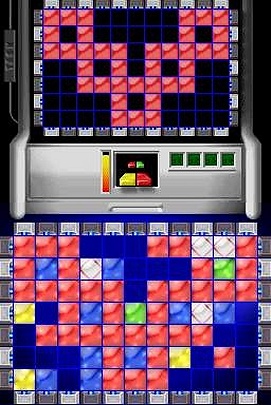 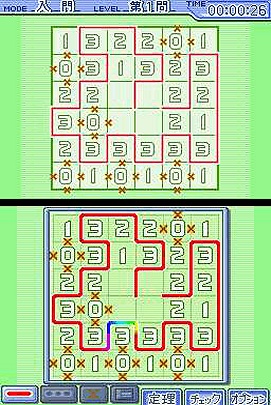
Occasionally, Task mode levels are at least in the shape of a boat or something.
KONDUCTRA (O3 Entertainment)
Western developers never quite seem to get it when it comes to creating original puzzle games, and O3's Konductra is the latest in a long line of not-quite-there efforts to add to the long-forgotten likes of Zoop and Endorfun. The idea is to lay two-block tiles horizontally or vertically on the playfield so that you can draw a line from one of the border tiles along a single-coloured path to another border tile the same colour as the one you started from. Every square you step on along the pathway disappears, scoring points depending on how far from the edge of the screen it is, and you can score up to 4x combos by completing multiple paths in a single continuous line. Alternatively, you can play a "Task" mode (depicted in the screenshot above), where you have to form the shape shown on the upper screen.
The game's main problem is that, like Gunpey, you can often find yourself in situations where you're just being delivered crap that you can't do anything with, and with only one piece ahead displayed, you can't afford to build up any ambitious lines because you risk the screen filling up with junk while you wait for the last tile you need to complete your path. So in Score mode you just end up making safe straight lines through the middle of the screen (where the big points are), and bunging useless pieces in the corners where you can clear them away easily - in such a manner, games can grind on for hours and days without ever becoming passingly interesting or fun. (There are no big payoffs, no screen-clearing powerups, no special explosions for big lines also taking out neighbouring blocks, or anything like that.) Task mode is a bit more intense, but you're still too much at the mercy of the random tiles for it to either feel like you've really achieved anything when you beat a level, or feel as if you can do better next time if you fail. Nice try, but no banana. 5/10
------------------------------------------------------------------------------------------
PUZZLE SERIES VOL.5: SLITHER LINK (Hudson Soft)
Now THIS is how to do a draw-a-continuous-line-around-a-grid puzzle game, saucer-eyed Occidentals. We've saved the best till last, in the shape of the only serious contender to the mighty Magnetica (aka ActionLoop) for the title of Greatest DS Puzzle Game Ever. Inexplicably never seen on a home format before (with the exception of a single Wonder Swan release with bafflingly bad controls for a system with two d-pads), Slither Link is, like Picross, merely one of a variety of generic names for a type of popular pen-and-paper puzzle, where the object is to draw a single continuous line around a grid of numbers such that every number is bordered by the line on exactly the specified number of sides. (If you don't quite follow that, a look at the screenshot should make everything clearer.)
This single simple rule results in the creation of the best logic puzzle this reporter's ever encountered. All the information you need is right in front of you, and piecing it together is as satisfying and rewarding an experience as you'll ever have with a games machine in your hand. Unlike Sudoku or Kakuro, you don't have to think down to several levels of "depth" simultaneously ("If this square contains either a four or a six AND the number in the next box is a seven or a two, then logically the bottom corner has to be a one or a five unless the one above it is another two, which it isn't, so if I can figure out whether the other one in this block is the eight or the nine I'll get all four boxes filled in at once, unless that slightly dodgy three I put in earlier was actually wrong."), so you can concentrate on the actual puzzle and not the mental strain of trying to remember lots of things. Unlike a Sudoku, in Slither Link it's a lot easier to solve a puzzle by working on nailing little individual sections at a time and then trying to connect them all together.
It might be comparatively "shallow", but that's in no way to suggest that Slither Link is a pushover. At first you'll struggle with even some of the introductory 6x6 grids (the game is structured in exactly the same way as Kakuro and Sudoku Grid Master and Illust Logic, with some puzzles in each grid size unlocked from the start, and more opened up by collecting stars), and 10x10s will regularly bring you close to tears - the very last few puzzles are a frankly totally terrifying 36x20, and I don't even want to think about those. Nevertheless, as you start to recognise patterns and get into the swing, you'll gradually find yourself able to knock off a typical 10x10 in two or three minutes rather than 25, and breaking one that initially seemed to be completely impossible will make you dance around the room in joy as the game plays its excited little celebratory fanfare.
It's beautifully constructed (save for an irritating and useless one-time tutorial that you should manage to bypass after some desperate random button-mashing), with an understated elegance that's surprisingly beautiful to behold - obviously, it doesn't look much in static screenshots - as the little rainbow that signifies an unbroken line glides its way around the grid reassuringly. Beyond the tutorial the Japanese text presents no obstacle whatsoever, and there are both stylus and (superior) d-pad controls, along with a convenient array of tools (like dotted lines for bits you're not yet 100% sure about). It'll take you scores of hours, maybe hundreds, to exhaust the 270 puzzles supplied, longer yet to get perfect ratings on all of them and collect all the stars, and even when you've beaten the entire thing you'll have long forgotten how you did the earlier puzzles, so you can just delete your save game and start again. And for sheer time-evaporating pleasure, accompanied by an effectively infinite lifespan (and because unlike Magnetica it doesn't come perilously close to undoing all its good work with fucking blowing-into-the-mic levels), Slither Link deserves a perfect score. Not only the best DS puzzle game, but arguably the best DS game full stop. Glorious. 10/10
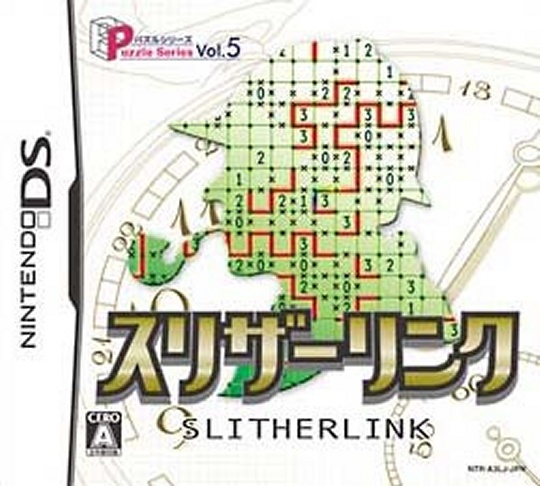
If it's endorsed by Sherlock Holmes, it must be good.
|

